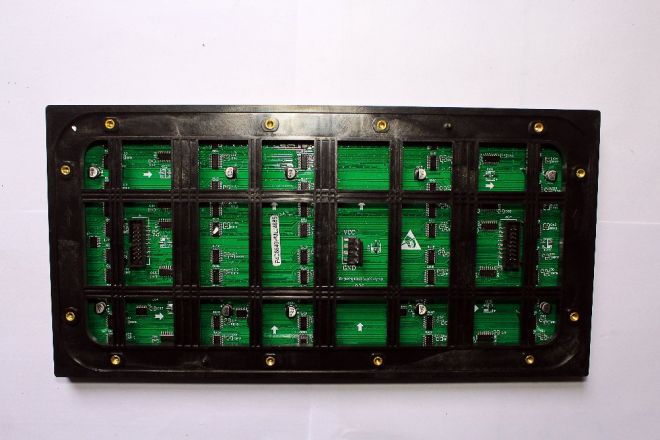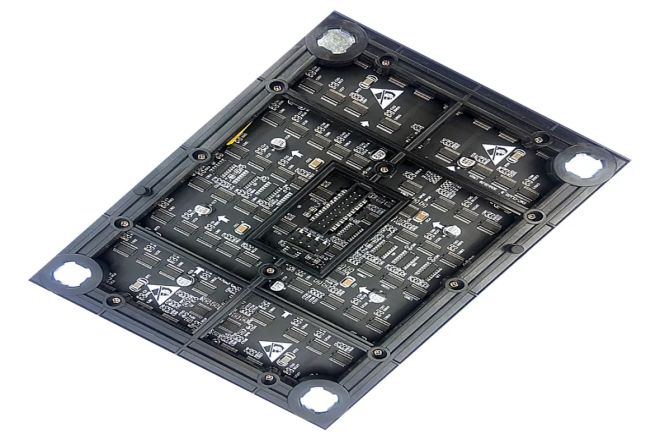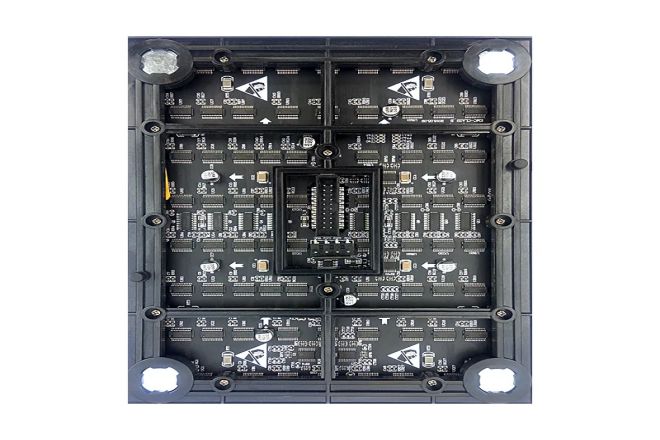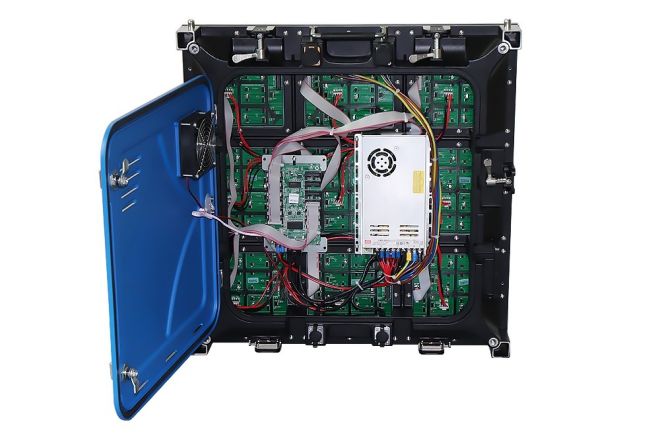مقدمة

اليوم، مع التطور السريع للرقمنة والمعلوماتية، يعرض الصمام أصبحت شاشات العرض LED جزءًا لا غنى عنه من حياتنا اليومية. سواء كانت منطقة تجارية مزدحمة أو مكانًا رياضيًا مهيبًا، توفر لنا شاشات العرض LED مجموعة واسعة من المعلومات المرئية بفضل سطوعها العالي ودقتها العالية وألوانها الزاهية.
وراء ذلك، تلعب لوحة وحدة شاشة LED دورًا رئيسيًا. باعتبارها المكون الأساسي لشاشة عرض LED، فإن أداء وجودة لوحة الوحدة تؤثر بشكل مباشر على تأثير العرض وعمر خدمة شاشة العرض بالكامل. لذلك، فإن فهم المعرفة الأساسية للوحات وحدة شاشة LED له أهمية كبيرة بالنسبة لنا لتطبيق شاشات LED وصيانتها بشكل أفضل.
1. المفاهيم الأساسية للوحة وحدة العرض LED
لوحة وحدة العرض LED، والتي تسمى أيضًا وحدة العرض LED أو ببساطة لوحة الوحدة، هي وحدة المكون الرئيسية لشاشة العرض LED. تلعب دورًا أساسيًا في شاشة العرض بأكملها، وهي مسؤولة عن عرض الصور والنصوص، وهي أساس العرض لشاشة العرض LED.
المكونات الأساسية للوحة الوحدة تشمل بشكل رئيسي خرزات مصباح LED، ودوائر القيادة، ولوحات PCB (لوحات الدوائر المطبوعة)، وأجزاء أخرى.
- حبات مصباح LED:
تُعد حبات مصباح LED هي الجسم الرئيسي للوحة الوحدة التي تصدر الضوء وتكون مسؤولة عن توليد الضوء. يتم دمج حبات المصباح هذه في ترتيب معين، ومن خلال التحكم في تشغيلها وإيقافها وسطوعها، يمكن عرض صور ونصوص متنوعة.
- دائرة القيادة:
دائرة القيادة هي الجزء الرئيسي للتحكم في إضاءة وإضاءة حبات مصباح LED. تتلقى إشارات من نظام التحكم (مثل المتحكم الدقيق، وشريحة بوابة المنطق TTL، وما إلى ذلك)، ثم تحول هذه الإشارات إلى إشارات تيار يمكنها تشغيل حبات مصباح LED. يؤثر أداء دائرة القيادة بشكل مباشر على تأثير العرض واستقرار شاشة LED.
- مجلس الكلور:
لوحة PCB هي الركيزة للوحة الوحدة وتحمل مكونات مثل خرزات مصباح LED ودوائر القيادة. إن تصميم وجودة تصنيع لوحات PCB لها تأثير مهم على أداء لوحات الوحدة. يجب أن تتمتع بموصلية جيدة واستقرار وتبديد للحرارة لضمان عمل خرزات مصباح LED ودائرة القيادة بشكل صحيح.
بالإضافة إلى ذلك، تتضمن لوحة الوحدة أيضًا بعض المكونات المساعدة، مثل مجموعات البلاستيك والموصلات وما إلى ذلك، والتي تُستخدم لتثبيت وحماية المكونات مثل حبات مصباح LED ودوائر القيادة، بالإضافة إلى تحقيق الاتصال والتثبيت بين لوحات الوحدة.
في صناعة شاشات LED، يتم تقسيم لوحات الوحدات إلى فئتين: لوحات الوحدات الداخلية ولوحات الوحدات الخارجية، وفقًا لبيئة الاستخدام وخصائص الأداء.
تُسمى لوحات الوحدة الداخلية عمومًا بالتركيب السطحي (التركيب السطحي ثلاثة في واحد)، والتي تتميز بخصائص دقة الصورة العالية والألوان الغنية، ولكن السعر مرتفع نسبيًا؛ تتميز لوحات الوحدة الخارجية بخصائص السطوع العالي ومقاومة الماء ومقاومة الطقس الجيدة، ولكن يتطلب التثبيت إرشادات فنية.
2. أنواع لوحات وحدات العرض LED

يمكن تقسيم لوحات العرض LED إلى أنواع عديدة وفقًا للبيئة التي تُستخدم فيها وخصائص أدائها. فيما يلي بعض الأنواع الشائعة وخصائصها والسيناريوهات القابلة للتطبيق:
1). لوحة وحدة العرض LED الداخلية:
- سمات:
تتميز هذه الألواح بدقة صورة عالية وألوان غنية وإعادة إنتاج ألوان جيدة وقادرة على تقديم تأثيرات صور وفيديو دقيقة. وفي الوقت نفسه، نظرًا لأن البيئة الداخلية مستقرة نسبيًا، فإن هذا النوع من الألواح لا يحتاج عادةً إلى اعتباره مقاومًا للماء أو الغبار أو غير ذلك من الخصائص.
- السيناريوهات القابلة للتطبيق:
يتم استخدامه بشكل أساسي في الإعلانات التجارية والمؤتمرات الداخلية والمعارض والأماكن الأخرى التي تتطلب شاشة عالية الدقة، مثل مراكز التسوق وقاعات المؤتمرات والمتاحف وما إلى ذلك.
2). لوحة وحدة العرض LED الخارجية:
- سمات:
سطوع عالي؛ قادر على الحفاظ على عرض واضح تحت أشعة الشمس القوية؛ مقاوم للماء والغبار ومضاد للتآكل؛ قادر على التكيف مع الظروف البيئية الخارجية المعقدة والمتغيرة؛ زاوية رؤية واسعة، مما يضمن أن المشاهدين من زوايا مختلفة يمكنهم رؤية صور واضحة.
- السيناريوهات القابلة للتطبيق:
يتم استخدامه بشكل أساسي في الإعلانات الخارجية، والأماكن الرياضية، والجدران الخارجية للمباني، وأماكن العرض الأخرى التي تتطلب مساحات كبيرة، وسطوعًا عاليًا، وثباتًا عاليًا.
3). لوحة وحدة العرض LED شبه الخارجية:
- سمات:
بين النوع الداخلي والنوع الخارجي، يتمتع بقدرات معينة على مقاومة الماء والغبار، لكن السطوع أقل قليلاً من النوع الخارجي. في الوقت نفسه، نظرًا لأنه لا يتطلب سطوعًا عاليًا بشكل خاص، فإن استهلاكه للطاقة منخفض نسبيًا.
- السيناريوهات القابلة للتطبيق:
يستخدم بشكل أساسي في البيئات شبه الخارجية، مثل الممرات والشرفات وتحت الأفاريز والأماكن الأخرى التي تتطلب قدرات معينة مقاومة للماء والغبار.
4). لوحة وحدة العرض LED عالية الكثافة:
- سمات:
يمكن لكثافة البكسل العالية تحقيق تأثيرات عرض ذات دقة أعلى؛ وهي مناسبة للعرض عن قرب، ويمكنها تقديم صور ونصوص أكثر دقة.
- السيناريوهات القابلة للتطبيق:
يتم استخدامه بشكل أساسي في الأماكن التي تتطلب شاشة عالية الدقة، مثل جدران التلفزيون ومراكز المراقبة ومراكز القيادة وما إلى ذلك.
تجدر الإشارة إلى أن التصنيف المذكور أعلاه ليس مطلقًا. قد تختلف خصائص لوحات وحدات العرض LED من مختلف الشركات المصنعة والنماذج وسيناريوهات التطبيق. عند الاختيار، يجب إجراء اعتبارات شاملة بناءً على الاحتياجات المحددة وبيئة الاستخدام.
3. مبدأ عمل لوحة وحدة العرض LED
يتضمن مبدأ عمل لوحة وحدة العرض LED مبدأ إضاءة حبات مصباح LED وطريقة التحكم في دائرة القيادة. فيما يلي نظرة عامة سريعة على كيفية عملها:
- مبدأ الإضاءة في حبات مصباح LED
LED (الصمام الثنائي الباعث للضوء) هو جهاز أشباه الموصلات يعتمد مبدأ انبعاث الضوء فيه على تأثير التلألؤ الكهربائي للمواد أشباه الموصلات.
عندما يتم تطبيق جهد أمامي بين أشباه الموصلات من النوع P وأشباه الموصلات من النوع N في الصمام الثنائي الباعث للضوء، تنتقل الإلكترونات من أشباه الموصلات من النوع N إلى أشباه الموصلات من النوع P، بينما تنتقل الثقوب (المواضع التي تفتقر إلى الإلكترونات) من أشباه الموصلات من النوع P إلى أشباه الموصلات من النوع N.
عندما تلتقي الإلكترونات والثقوب وتتحد مرة أخرى عند الوصلة PN، يتم إطلاق الطاقة. تنبعث هذه الطاقة في شكل فوتونات، وهو الضوء الذي نراه من الصمام الثنائي الباعث للضوء.
- طريقة التحكم في دائرة القيادة.
دائرة التحكم في لوحة وحدة العرض LED مسؤولة بشكل أساسي عن التحكم في سطوع خرزات مصباح LED عند التشغيل والإيقاف. تتلقى دائرة التحكم إشارات من نظام التحكم، ومن خلال فك التشفير والتحويل، تحول هذه الإشارات إلى تعليمات يمكنها التحكم في تيار خرزات مصباح LED.
يمكن لهذه التعليمات التحكم بشكل مباشر في تشغيل وإيقاف حبة مصباح LED، أو يمكنها ضبط التيار المتدفق عبر حبة مصباح LED للتحكم في سطوعها.
بالنسبة لشاشات LED الملونة، تحتاج دائرة القيادة أيضًا إلى التحكم في حبات مصباح LED بألوان مختلفة لتحقيق شاشة ملونة بالكامل. يتم تحقيق ذلك عادةً من خلال التحكم في سطوع مجموعة من حبات مصباح LED باللون الأحمر والأخضر والأزرق.
- الدور الرئيسي للوحة الوحدة هو عرض الصور والنصوص ومقاطع الفيديو وغيرها من المعلومات.
لوحة وحدة العرض LED هي الوحدة الأساسية التي تشكل شاشة LED بالكامل. تحقق عرض الصور من خلال التحكم في سطوع خرزات مصباح LED وتشغيلها وإيقاف تشغيلها. عند عرض معلومات مثل الصور والنصوص ومقاطع الفيديو وما إلى ذلك، سيحول نظام التحكم إشارة الإدخال إلى تنسيق مناسب لمعالجة لوحة وحدة العرض LED ثم ينقلها إلى لوحة الوحدة.
بعد تلقي هذه الإشارات، ستقوم دائرة التحكم في لوحة الوحدة بالتحكم في تشغيل وإيقاف سطوع حبات مصباح LED وفقًا للإرشادات، وبالتالي عرض الصورة أو المعلومات المطلوبة.
نظرًا لأن لوحة وحدة العرض LED مرنة للغاية وقابلة للتحكم، فيمكنها تحقيق تأثيرات عرض معقدة مختلفة، مثل الصور الديناميكية ومقاطع الفيديو والترجمات الدوارة وما إلى ذلك.
في الوقت نفسه، نظرًا لسطوعها العالي وزاوية رؤيتها الواسعة واستهلاكها المنخفض للطاقة، تم استخدام شاشات LED على نطاق واسع في مناسبات مختلفة، مثل الإعلانات التجارية والأماكن الرياضية والعروض المسرحية وما إلى ذلك.
4. معلمات أداء لوحة وحدة العرض LED

تلعب معلمات الأداء الرئيسية للوحة وحدة العرض LED دورًا رئيسيًا في تأثير العرض والأداء العام. فيما يلي شرح لبعض المعلمات الرئيسية وتأثيرها:
1) كثافة البكسل:
الشرح: تشير كثافة البكسل إلى عدد البكسلات لكل وحدة مساحة، والتي يتم التعبير عنها عادةً بـ "بكسل لكل متر مربع، ppm" (بكسل لكل متر مربع، ppm) أو "خطوة النقطة" (خطوة النقطة). كلما كانت خطوة النقطة أصغر، زادت كثافة البكسل وأصبحت الصورة أكثر وضوحًا.
التأثير: تؤدي كثافة البكسل العالية إلى الحصول على صور أكثر تفصيلاً ووضوحًا، خاصة عند مشاهدتها عن قرب. لذلك، في المناسبات التي تتطلب شاشات عالية الدقة، مثل الإعلانات التجارية وقاعات المؤتمرات وما إلى ذلك، تعد كثافة البكسل مؤشرًا مهمًا.
2) السطوع:
الشرح: يشير السطوع إلى شدة الضوء المنبعث من شاشة LED، والتي يتم التعبير عنها عادةً بـ "كانديلا لكل متر مربع" (cd/m²).
التأثير: كلما زاد السطوع، لا يزال بإمكان الشاشة الحفاظ على تأثير عرض واضح في الهواء الطلق أو في بيئة مضاءة بشكل ساطع. لذلك، تتطلب شاشات LED الخارجية عادةً سطوعًا أعلى. ومع ذلك، قد يؤدي السطوع المرتفع جدًا أيضًا إلى زيادة استهلاك الطاقة وعدم الراحة أثناء المشاهدة.
3) التباين:
الشرح: يشير التباين إلى نسبة السطوع بين الجزء الأكثر سطوعًا والجزء الأكثر قتامة على الشاشة. ينتج التباين العالي صورًا أكثر وضوحًا وحيوية.
التأثير: التباين أمر بالغ الأهمية لإحساس العمق والأبعاد في الصورة. توفر الشاشة عالية التباين ألوانًا أكثر ثراءً ودرجات لون أسود أعمق، مما يجعل الصور أكثر حيوية وواقعية.
4) المنظور:
الشرح: تشير زاوية الرؤية إلى أقصى زاوية يمكن من خلالها رؤية محتوى الشاشة بوضوح من الجانبين الأيسر والأيمن للاتجاه الطبيعي للشاشة. تحدد زاوية الرؤية الأفقية وزاوية الرؤية الرأسية معًا نطاق رؤية الشاشة.
التأثير: تعني زاوية المشاهدة الأكبر أن المزيد من الأشخاص يمكنهم رؤية محتوى الشاشة بوضوح من زوايا مختلفة. لذلك، في المواقف التي يحتاج فيها العديد من الأشخاص إلى المشاهدة في نفس الوقت، مثل غرف المؤتمرات والملاعب وما إلى ذلك، تكون زاوية المشاهدة الأكبر ضرورية.
بالإضافة إلى المعلمات المذكورة أعلاه، تحتوي لوحة وحدة العرض LED أيضًا على معلمات أداء أخرى، مثل درجة حرارة اللون ومعدل التحديث والتدرج الرمادي وما إلى ذلك. ستؤثر هذه المعلمات أيضًا على الأداء العام للشاشة. في التطبيقات العملية، من الضروري اختيار لوحة وحدة العرض LED المناسبة وفقًا للاحتياجات المحددة وبيئة الاستخدام.
5. مجالات تطبيق لوحة وحدة العرض LED
تُستخدم لوحات العرض LED على نطاق واسع في العديد من المجالات. تجعلها أدائها وخصائصها الفريدة أداة مهمة في وسائل الإعلان والعروض المسرحية والأماكن الرياضية وتعليمات المرور وغيرها من المجالات. فيما يلي أوصاف التطبيقات في هذه المجالات وبعض أمثلة مشاريع العرض LED النموذجية:
- مجال الاعلام الاعلاني
في مجال وسائل الإعلان، يمكن لوحدات العرض LED تقديم معلومات إعلانية وأنشطة ترويجية بسرعة وفي الوقت الفعلي مع دعم عرض محتوى إعلاني عالي الدقة وديناميكي، مما يجذب انتباه الناس بشكل كبير ويزيد من الوعي بالعلامة التجارية والتعرض لها.
على سبيل المثال، قدمت شركة Leyard، إحدى العلامات التجارية الرائدة في صناعة LED، شاشة LED للملعب بمساحة إجمالية تبلغ نحو 2000 متر مربع لكأس العالم في قطر، مما أدى إلى تحسين تأثير العرض للملعب بشكل شامل وجلب تجربة حدث رائعة للجماهير في جميع أنحاء العالم.
2) مجال الأداء المسرحي
في العروض المسرحية، لا تعمل لوحات العرض LED على تحسين تأثير الإضاءة فحسب، بل يمكن استخدامها أيضًا كديكور للمسرح، أو إضاءة خلفية، وما إلى ذلك، مما يوفر للجمهور معلومات تتجاوز الأداء نفسه.
في السنوات الأخيرة، أصبحت شاشات العرض الإلكترونية LED بمثابة دعامة متعددة الوسائط لا غنى عنها للعروض المسرحية، حيث تعمل على إثراء محتوى العرض وتوفير تجربة بصرية أكثر تنوعًا للجمهور.
على سبيل المثال، لعب استخدام الشاشات الكبيرة دوراً مهماً للغاية في حفلي افتتاح واختتام "دورة الألعاب الرياضية العاشرة لجمهورية الصين الشعبية" وحفل افتتاح "مهرجان السياحة والثقافة الدولي".
3) ملعب الملعب
في الأماكن الرياضية، يمكن لوحدات العرض LED عرض معلومات الحدث والنتائج والإعلانات والمحتويات الأخرى في الوقت الفعلي، مما يوفر للجمهور معلومات دقيقة وفي الوقت المناسب ويعزز تجربة المشاهدة.
في الوقت نفسه، تعرض وظيفة تشغيل الفيديو عالي الدقة صور الحدث بشكل أكثر وضوحًا وواقعية، مما يحسن التجربة البصرية للجمهور. على سبيل المثال، اختار ملعب شنغهاي شاشة سماوية تبلغ مساحتها حوالي 10000 متر مربع بناها شنغهاي سانسي لإضاءة الملعب بالكامل وتقديم تجربة مشاهدة أكثر إثارة للجمهور.
4) منطقة تعليمات المرور
في مجال تعليمات المرور، يمكن استخدام لوحة وحدة العرض LED كلوحة معلومات متغيرة لتحديث المعلومات في الوقت الفعلي، وتزويد السائقين والمشاة المارين بمعلومات مسار المرور في الوقت المناسب، مثل الاختناقات المرورية وإغلاق الطرق وما إلى ذلك، وتوجيه المركبات للقيادة على الطرق المحددة.
بالإضافة إلى ذلك، يمكن لشاشة العرض LED في مراقبة الطريق أيضًا عرض مسافة الحد الأقصى للسرعة أو معلومات المرور المختصرة لقسم الطريق لتذكير المركبات بالقيادة عند الحد الأقصى للسرعة وضمان سلامة القيادة. توفر هذه الوظائف دعمًا قويًا لتطوير أنظمة النقل الذكية.
6. اتجاهات تطوير لوحات العرض LED

باعتبارها المكون الأساسي لشاشة العرض LED، كان التطور التكنولوجي للوحة وحدة العرض LED رائدًا في تقدم صناعة العرض LED بأكملها. في الوقت الحاضر، ينعكس اتجاه تطوير تقنية لوحة وحدة العرض LED بشكل أساسي في جوانب مثل الدقة العالية والذكاء وتوفير الطاقة.
- عالية الدقة:
مع التقدم المستمر لتكنولوجيا العرض، تستمر كثافة البكسل في لوحات وحدات العرض LED في الزيادة، ويصبح تأثير العرض أكثر وضوحًا. في المستقبل، ستكون الدقة العالية أحد الاتجاهات المهمة لتطوير تكنولوجيا لوحات وحدات العرض LED.
ستؤدي كثافة البكسل الأعلى وتأثيرات العرض الأكثر دقة إلى جعل شاشات LED تُستخدم على نطاق واسع في وسائل الإعلان والعروض المسرحية والأماكن الرياضية وغيرها من المجالات.
- ذكاء:
الذكاء هو اتجاه مهم آخر في تطوير تكنولوجيا لوحة وحدة العرض LED. من خلال دمج أجهزة استشعار وخوارزميات ذكية مختلفة، ستتمكن شاشات LED من تحقيق وظائف تفاعل أكثر ثراءً بين الإنسان والحاسوب، مثل التعرف على الصوت والتعرف على الحواس الجسدية وما إلى ذلك.
وفي الوقت نفسه، من خلال الجمع بين الحوسبة السحابية والبيانات الضخمة وغيرها من التقنيات، ستتمكن شاشات LED من تحقيق قدرات معالجة بيانات أكثر قوة ووظائف اتخاذ القرار الذكي، مما يوفر للمستخدمين خدمات أكثر ملاءمة وكفاءة.
- توفير الطاقة:
مع التحسن المستمر للوعي البيئي، أصبح توفير الطاقة أيضًا اتجاهًا مهمًا لتطوير تقنية لوحة وحدة العرض LED. من خلال استخدام مواد مضيئة ودوائر قيادة أكثر كفاءة، ستتمكن شاشات LED من تحقيق استهلاك أقل للطاقة وعمر خدمة أطول.
وفي الوقت نفسه، سيتم أيضًا استخدام بعض تقنيات توفير الطاقة الجديدة، مثل وحدات LED اللاسلكية الموفرة للطاقة، على نطاق واسع في لوحات وحدات العرض LED لتحسين أدائها في توفير الطاقة بشكل أكبر.
في المستقبل، تشمل اتجاهات التطوير المحتملة لتكنولوجيا لوحة وحدة العرض LED الجوانب التالية:
- التصغير:
مع التقدم المستمر للتكنولوجيا، سيستمر حجم لوحات وحدات العرض LED في الانكماش وتحقيق التصغير. وهذا من شأنه أن يجعل شاشات LED تستخدم على نطاق واسع في الأجهزة القابلة للارتداء والمنازل الذكية وغيرها من المجالات.
- المرونة:
ستتطور تقنية شاشات LED المرنة تدريجيًا وسيتم تطبيقها على المنتجات الفعلية. تتميز شاشات LED المرنة بخصائص الانحناء والطي، مما يجعل شاشات LED أكثر مرونة من حيث الشكل والحجم.
- الشفافية:
ستصبح تقنية شاشات LED الشفافة شائعة الاستخدام تدريجيًا في المزيد من السيناريوهات. يمكن لشاشات LED الشفافة تحقيق وظائف العرض الشفافة والتفاعلية، مما يمنح المستخدمين تجربة بصرية أكثر تميزًا.
من منظور آفاق السوق، مع التطوير المستمر لتكنولوجيا شاشات LED والتوسع المستمر في مجالات التطبيق، سيستمر الطلب في السوق على لوحات وحدات العرض LED في النمو.
وخاصة في مجالات وسائل الإعلان والعروض المسرحية والأماكن الرياضية وغيرها من المجالات، سوف يفضل المزيد من المستخدمين لوحات العرض LED عالية الدقة والذكية والموفرة للطاقة. وفي الوقت نفسه، مع ظهور وتطبيق التقنيات الجديدة بشكل مستمر، سوف تكون آفاق سوق لوحات العرض LED أوسع.
خاتمة
من خلال هذه المقدمة الموجزة، ليس من الصعب رؤية المكانة المهمة للوحات العرض LED في تكنولوجيا العرض الحديثة. مع التقدم المستمر للعلوم والتكنولوجيا والطلب المتغير في السوق، يتم أيضًا تحديث تكنولوجيا لوحات العرض LED وترقيتها باستمرار.
أخيرًا، إذا كنت تريد معرفة المزيد عن شاشات LED، يرجى الحصول على اتصال معنا.
